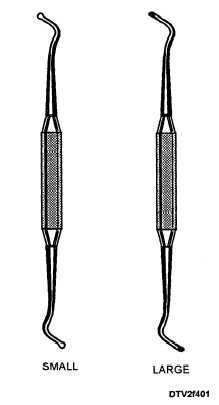Back
Chapter 4 Operative Dentistry | Up
Dental Technican, Volume 2 - Dentist training manual for military dentists | Next
AMALGAM CARRIERS |
Figure 4-1.—Small and large spoon excavators. Figure 4-2.—Wedelstaedt and biangle chisels. Figure 4-3.—Hatchet. at a 45- to 90-degree angle from the shank. These instruments have different lengths and widths of blades. Hatchets are used on the wall of the cavity preparation to cleave enamel and cut dentin so there will be a sharp cavity outline. Hoes Dental hoes (fig. 4-4) look like a miniature garden hoe. They are used with a pulling motion to smooth and shape the floor and sides of cavity preparations. Hoe blades are set at a 45- to 90-degree angle from their handle. Gingival Margin Trimmers (GMTs) The gingival margin trimmers (GMTs) (fig. 4-5) are modified hatchets that have working ends with opposite curvatures and bevels. As the name implies, GMTs are used to trim, smooth, and shape the gingival floor of a cavity preparation. GMTs are available in double-ended styles and are used in pairs, such as the #26 and #27. This is because the working ends of the even-numbered instruments are designed for use on the distal surfaces, and the odd numbered are used on the mesial surfaces. AMALGAM RESTORATION INSTRUMENTS The instruments discussed in this section are used when the dentist elects to use an amalgam or a temporary dental material to restore a tooth. 4-2 d Figure 4-4.—Hoe. Figure 4-5.—Gingival margin trimmers (GMTs). Condensing Instruments To deliver the amalgam to the cavity preparation and properly condense (pack) it, the dentist will use a variety of instruments. Amalgam carriers and condensers are used for this purpose. completed, eject any remaining a: nalgam alloy from the carrier into the amalgam well The carrier is no longer serviceable when the amalgam is allowed to harden in the carrier. CONDENSERS. —Amalgam condensers, often called pluggers, are instruments used to condense or AMALGAM CARRIERS.—Amalgam carriers (fig. 4-6) transport the freshly prepared amalgam restorative material to the cavity preparation. These carriers have hollow working ends, called barrels, into which the amalgam is packed for transportation. Both single and double-ended carriers are available with a variety of barrel sizes including: mini, large, and jumbo. When the lever (located on the top of the carrier) is depressed, the amalgam is ejected into the cavity preparation. Normally, two carriers are used during the amalgam placement procedure. This saves time for the dentist who is ejecting or condensing a carrier load while you are refilling the carriers. A poorly packed carrier of amalgam handed to the dentist may fall out before it is ejected into the cavity preparation. It is your responsibility to ensure that all carriers are properly packed before the transfer to the dentist. After amalgam material placement is pack the amalgam filling materials into the cavity preparation. The hammer-like working end is large enough to compress the soft amalgam without sinking into it. Condensers come in single- and double-ended designs. They have various shaped and sized working ends, which may be smooth or serrated as shown in figure 4-7. Carvers After the amalgam is condensed, it must then be carved to approximately the same original tooth structure. Carvers have sharp cutting edges that are used to shape, form, or cut tooth anatomy into amalgam restorations. Figure 4-8 illustrates these instruments that come in assorted shapes and sizes in double-ended designs. Many carvers were designed for carving specific tooth surfaces. The Interproximal and #1/2 Hollenback were designed for carving proximal (in between) tooth surfaces; whereas, the discoid-cleoid # 89/92 and Tanner #5 are used on occlusal surfaces. Carvers shaped similar to Vignon or Frahm #2/3 (also Figure 4-6.—Amalgam carriers. Figure 4-7.—Amalgam condensers. called acorn carvers) are used to quickly carve the basic anatomy on occlusal surfaces. As with condensers, dentists also have favorite carvers that they use routinely. You must know the dentist's preference so that you can have the desired instrument ready when it is needed. Burnishers When the carving is complete, the dentist may use burnishers to smooth and polish the restoration, and to remove scratches left on the amalgam surface by a carving instrument. Burnishers have smooth rounded
|














No comments:
Post a Comment